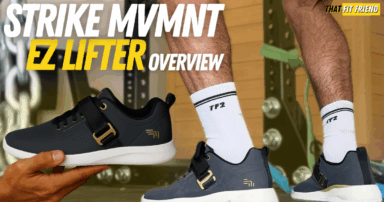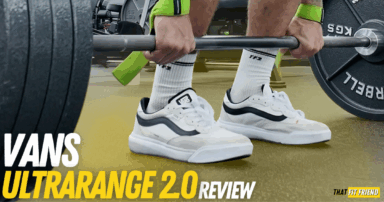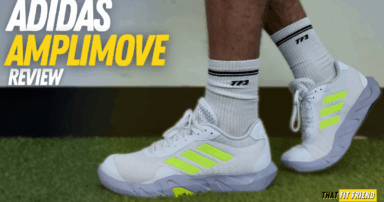Handfuls of questions that I receive on shoe reviews on my YouTube channel and from personal training clients revolve around choosing the best footwear for certain activities.
Barefoot lifting, training in cross-training shoes, and opting for weightlifting shoes for squats are all popular options and neither is necessarily better than the other, as they’re all contextual.
What I mean by this is that your footwear selection for working out should be dependent on the task at hand and your overall goals. For example, training barefoot can certainly have its time and place, along with wearing cross-training shoes and weightlifting shoes.
For Those In a Rush: Think of your footwear in the gym as your weapon of choice based on what you’re doing. Whether you’re wearing weightlifting shoes, cross-training shoes, or going barefoot (rocking barefoot shoes), there should be a rationale behind doing so.
- Barefoot Training: Great for deadlifts, minimalist lovers who want to feel the ground as much as possible, and lifters who want to passively train their feet while working out.
- Cross-Training Shoes: Great for versatile workouts where you’re lifting and doing athletic-style work, good for CrossFit, and useful for sessions where you want stability with a little more support under the feet.
- Weightlifting Shoes: Great for squats, clean & jerks, and snatches. Also useful for lifters who have ankle mobility limitations in their squats and need an elevated heel to maintain good form while hitting depth.
What Is Barefoot Lifting?
In its most simple definition, barefoot lifting is working out in a formal training setting in either socks, going fully barefoot, or even rocking barefoot shoes. A lot of different types of lifters and athletes will lift barefoot for a variety of reasons.
Some of the reasons for barefoot lifting are based on preference while others are rooted in performance reasons. I think everyone should play around with barefoot lifting at some point in their training career just to feel what it’s like to manage external loads with no material under the foot. Just make sure your gym allows it — don’t be that barefoot lifter at a commercial gym.
Benefits of Barefoot Lifting
When discussing the benefits of barefoot lifting, it’s important to separate personal preferential biases from actual benefits. For example, some lifters will tout multiple benefits of barefoot lifting, but when you pull back their rationale, all of the said benefits were only related to their personal preferences.
- Potentially Limit Range of Motion In Some Exercises
- Example: If you’re deadlifting, then you’ll want to limit the total range of motion you need to lift the weight. Let’s say you only have a pair of thick running shoes with you, opting to lift barefoot would be an appropriate strategy for maximizing deadlift performance in this context.
- Potentially Strengthen Foot Musculature
- There are a ton of muscles in the feet and training barefoot, can at times, be a viable strategy for strengthening the musculature in the feet, especially in more dynamic movements (lunges, split squats, etc.).
- Improve Foot Proprioception
- The ability to place and produce force through the targeted area on the feet is a skill. By lifting barefoot, at times, this strategy can be a better means to help you understand how to deviate and create force through specific areas on the feet because some thicker shoes can limit our potential to “feel” the ground beneath us.
The big takeaways here are that lifting barefoot is contextual and you should apply this strategy with reason and context. Above are three benefits that can contextually be appropriate for opting for barefoot lifting.
Drawbacks of Barefoot Lifting
Despite there being a few really good benefits, there are a couple of drawbacks to barefoot lifting.
- Not Great for the Unacclimated In Some Settings
- There are some training settings where going barefoot is likely not the best idea. For example, if you’re performing bounding activities and you haven’t acclimated yourself to the differences in force you’ll experience when training barefoot, then this strategy might be uncomfortable.
- Frowned Upon In Some Gyms
- A more topical drawback is the fact that some busy commercial gyms frown upon barefoot lifting, and for good reason, AKA sanitary purposes.
Similar to benefits, the drawbacks to barefoot lifting are contextual. This strategy does require an acclimation period for some exercises, so that’s important to remember when lifting barefoot.
When to Use Barefoot Lifting
Barefoot lifting should be used in settings where it’s appropriate and okay to do based on the exercises you’re performing and the rationale you have for training barefoot.
There’s no “one-size-fits-all” answer here and barefoot lifting should be employed as a means to an end based on your contextual training goals. If, for example, you’re deadlifting and you don’t have the appropriate shoes available, then this would be a good example of employing barefoot lifting.
Additionally, if you are working to improve your foot musculature, then using barefoot lifting with strategy can be super useful. On top of this, you could even explore active foot training variations which I’ve discussed briefly on my YouTube channel.
What Are Cross-Training Shoes?
Cross-training shoes are a sub-category of traditional training. Cross-training shoes have specific construction details that make them suitable for versatile training. They’re shoes designed to tackle things like lifting, plyometrics, and lighter runs all in one workout.
Cross-training shoes differ from traditional training shoes because they generally offer more stability in their midsole and outsole construction and have lower heel-to-toe drops. These cross-training shoe construction details are important to understand because there are a lot of models out there and not all are created equal for various tasks.
Benefits of Cross-Training Shoes
Cross-training shoes come with a plethora of benefits and the benefits they offer will ebb and flow based on how you plan to use them. Below, we’ll cover three key benefits that come along with cross-training shoes.
- More Stable Than Training Shoes
- With lower heel-to-toe drops and more stable midsoles and outsoles, cross-training shoes are viable options for lifters who plan to train heavy. Now, there is some variance between cross-training shoes and their stability, but overall, they’ll be much more stable options than traditional training and running shoes.
- They Feed Really Well Into Versatility
- If you want a pair of training shoes that can tackle pretty much any task you throw at them, then cross-training shoes are a really good bet. They’re kind of like a “best of all worlds” type of shoe for lifting, athletic training, HIIT workouts, shorter runs, and agility training.
- Come In All Shapes and Sizes
- Another benefit of cross-training shoes is that with the diverse selection on the market, pretty much everyone can find the perfect pair to match their fit and performance preferences.
Since cross-training shoes vary, their benefits will ebb and flow based on the activities you plan to use them with. If you’re someone who likes to lift and train diversely, then cross-training shoes will be a really good bet for you.
Drawbacks of Cross-Training Shoes
Much like the benefits above, the drawbacks of cross-training shoes will be contextual based on how you plan to use them in your training.
- Not Great for Running
- If you’re someone that does a lot of long runs in their training, then you’ll want to likely invest in a separate pair of running shoes. While you can run in cross-training shoes, they’re often not the best option when it comes to total comfort and performance in very niche-focused running settings.
- Great Variance Means Potential Mismatches
- What I mean by this is that every cross-training shoe varies slightly with construction and if you don’t know what to look for, then you may end up getting a pair of shoes that don’t really match your movement styles and preferences. A good example of this would be someone who needs a higher heel-to-toe drop model to help them get into dorsiflexion, but they end up getting a very minimalist heel-to-toe drop.
Honestly, the only real way you can go wrong with cross-training is if you force them to tackle activities they’re not designed to handle, or if you’re trying to force wear a model that doesn’t fit your movement style and foot anatomy.
When to Use Cross-Training Shoes
Cross-training shoes can be used in a variety of different training settings. I always suggest lifters and athletes just have a pair of cross-training shoes on deck for general training purposes. Plus, if you take care of your cross-training shoes they’ll usually last a while and be a solid investment.
Below is a list of activities for when you can and should use cross-training shoes.
- Recreational Lifting
- Agility Training
- Plyometrics
- Light/Short Runs
- Sprints
- HIIT Workouts
- Casual Walks
- Functional Fitness Training
Do note, that the list above is a general list and some cross-training shoes will excel in certain activities above others. That’s why it’s important to narrow down your gym shoe performance needs.
What Are Weightlifting Shoes?
Weightlifting shoes are shoes designed with key construction details to support training within the sport of weightlifting (a strength sport consisting of the snatch and clean & jerk) and general weight lifting. Weightlifting shoes have purposely elevated heels to provide the body with a more seamless means of getting into dorsiflexion.
In addition to elevated heels, weightlifting shoes also have very stable outsoles to provide lifters and athletes with maximal amounts of stability under external loads. When squatting, snatching, and doing things like clean & jerks, there are movement patterns that we should aim to achieve to optimize performance, and that is what weightlifting shoes are designed to do.
Benefits of Weightlifting Shoes
The benefits that come along with weightlifting shoes will all be specifically based on the activities they’re designed to be used for. This is important to understand because weightlifting shoes are not shoes that can be used in every single training setting.
- An Elevated Heel Supports Positioning
- When we’re lifting on an elevated heel, we’ll be able to feed into dorsiflexion a bit easier by assisting with more forward knee translation. An elevated heel will naturally put you into dorsiflexion, which can then help you produce stability by maintaining a more upright torso position.
- Increased Outsole Stability
- When training heavily, you want to feel stable and grounded with your feet. Weightlifting shoes come with very stable outsoles which makes them great options for promoting toe splay and stability when training heavy.
- Sport Specific
- Just like cleats in soccer, weightlifting shoes are beneficial for strength sports and exercises where they support your performance. If you can feel more stable when moving external loads while maintaining proper positioning, then you’ll be well on your way to support sport-specific goals. Weightlifting shoes, like all sports gear, are tools for promoting better performance.
Weightlifting shoes are specific and not everyone needs a pair for their training. However, understanding the “why” of weightlifting shoes can help you make an educated buying decision as to whether you should keep a pair on deck.
Drawbacks of Weightlifting Shoes
The only two real drawbacks to weightlifting shoes are not understanding how to use them and when they’re appropriate in training, and the fact that they can be pretty pricey.
- Thinking They’re Highly Versatile
- Weightlifting shoes are specific and will not be useful in a variety of settings. For example, they’re not going to be your best for your versatile workouts. If you’re someone who wants them to train heavily, then I’d highly suggest also having a pair of training shoes for accessories and other work after your dedicated strength/power work.
- Can Be a Bit Pricey
- Most weightlifting shoes cost around $200, but some budget-friendly options exist. That being said, weightlifting shoes are an investment, so it’s important to consider their price and take care of them to ensure they go the distance.
To be honest, I don’t like to say there are any real drawbacks to weightlifting shoes. In reality, there’s only a misunderstanding at times on how to use them to properly support your training goals.
When to Use Weightlifting Shoes
If you’re new to weightlifting shoes, then I’d suggest checking out the list below for when to use them to support your performance.
If you have further questions, always feel free to reach out and ask specifics as you have them.
- Competing/Training In the Sport of Weightlifting (snatch and clean & jerk)
- When Performing a High Volume of Olympic Lifts
- When Positioning Is Key for Performance Outcomes
- Essentially, when you’re training and you notice a weightlifting shoe heel supports your ability to maintain various positions. You can be at any skill level to benefit here!
Unlike cross-training shoes, weightlifting shoes have a much more narrow lens when using them. It’s important to note that any level of lifter can benefit from using them and understanding how their construction can change and support lifting mechanics is important.
Takeaway Thoughts
Barefoot lifting, wearing cross-training shoes, and using weightlifting shoes all have their appropriate times and places. As you continue on your training journey, being able to understand the why behind each of the footwear options above is important.
Footwear can play a role in lifting mechanics and performance outcomes, so spend a little bit of time researching what you like to use and what you want to use to get the most bang for your buck.











Matthew Stewart
Jake thanks for the comparisons and analysis of different types of shoes in different exercise arenas! I am a 6’2” 245lb -47 yr old CrossFit athlete and have struggled with knee pain in the past two years. Mostly from mobility issues. I have read a lot of articles about benefits of going barefoot and probably just as many articles about disadvantages. I have concerns that even with acclimating this might still be a challenge for me given my size and knee issues. However if it could help long term I’m willing to make the investment. I’m curious your experience with similar circumstances and thoughts?
Hey! Regarding footwear selection, I tend to have a different point of view compared to the “all-in” style folks out there and I’ll share more on that below. Now, when it comes to your context of mobility causing potential discomfort…footwear may be playing a small role, but honestly, programming and what you’re doing to improve that aspect would take priority. For example, if the ankles are limiting you, are you adding in exercises to work on ankle mobility like calve raises frequently enough, are you focusing on the hips/are they the limiters, and are your mechanics dialed in for your anatomy/are they playing a role here?
Those are all questions I would focus on before necessarily going straight to shoe selection being the culprit. When it comes to integrating in barefoot shoes, I think it can be useful to understand that there doesn’t have to an “all-in” style shift. For example, you could easily start wearing barefoot shoes for some walks/daily wear and get the benefits of building your feet/working through different ROMs without having to change your entire training style/movement mechanics (because going from a drop to zero drop can influence this, plus, impact and force changes should be accounted for).
In your case, I think taking a step back and taking a bigger picture look of your programming would be super useful, then you could integrate in different styles of footwear based on your preferences/what allows you to perform your best. It takes a little bit of work to plug and play here, but once you find a flow that works for you, I think you’ll be much more in-tuned with your body/what helps you perform the best!
I hope that helps! I could go on all day about this and if you need further help, hit me on IG and I can send some video feedback/thoughts as that’s easier to ramble with, LOL.